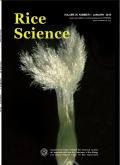Molecular Evolution of Rice Blast Resistance Gene bsr-d1
IF 5.6
2区 农林科学
Q1 AGRONOMY
引用次数: 0
Abstract
Rice blast, caused by the fungus Magnaporthe oryzae, reduces rice yields by 10% to 35%. Incorporating blast resistance genes into breeding programs is an effective strategy to combat this disease. Understanding the genetic variants that confer resistance is crucial to this strategy. The gene Bsr-d1 encodes a C2H2-like transcription factor, and its recessive allele confers broad-spectrum resistance against infections by various strains of M. oryzae. In this study, we investigated the molecular evolution of the rice blast resistance gene bsr-d1 in a representative population consisting of 827 cultivated and wild rice accessions. Our results revealed that wild rice exhibited significantly higher nucleotide diversity, with polymorphic regions primarily concentrated in the promoter region, in contrast to indica and japonica rice varieties. The Bsr-d1 gene displayed significant differentiation between indica and japonica rice varieties, with the bsr-d1 resistance allele being unique to indica rice. Haplotype network and phylogenetic analyses suggested that the bsr-d1 resistance allele most likely originated from Oryza nivara in the region adjacent to the Indian Peninsula and the Indochina Peninsula. Moreover, we explored the utilization of bsr-d1 resistance alleles in China and designed a pair of DNA primers based on the polymorphic sites for the detection of the bsr-d1 resistance gene. In summary, our study uncovering the origin and evolution of bsr-d1 will enhance our understanding of resistance gene variation and expedite the resistance breeding process.
求助全文
约1分钟内获得全文
求助全文
来源期刊

Rice Science
Agricultural and Biological Sciences-Agronomy and Crop Science
CiteScore
8.90
自引率
6.20%
发文量
55
审稿时长
40 weeks
期刊介绍:
Rice Science is an international research journal sponsored by China National Rice Research Institute. It publishes original research papers, review articles, as well as short communications on all aspects of rice sciences in English language. Some of the topics that may be included in each issue are: breeding and genetics, biotechnology, germplasm resources, crop management, pest management, physiology, soil and fertilizer management, ecology, cereal chemistry and post-harvest processing.
 求助内容:
求助内容: 应助结果提醒方式:
应助结果提醒方式:


